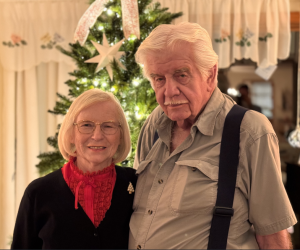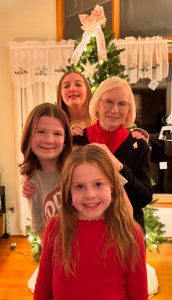CPR Saves Jacksonville Woman’s Life at Local Walmart

It was just a normal day of running errands last September when the unthinkable happened. Sid Welles waited in the car while his wife Evelyn ran into the store to pick up a gallon of milk, but the quick errand became dangerous when she collapsed in the self-checkout line at the Jacksonville Walmart.
The 73-year-old had experienced ventricular fibrillation, a quivering of the heart muscles, which leads to blood stoppage. The condition can lead to cardiac arrest and death if emergency actions aren’t immediate. Sid waited and waited, even moving the car up closer to the door, but still Evelyn didn’t return. When he heard rescue vehicles screeching into the parking lot, he knew something was wrong.
“I got a really bad feeling and went in,” Sid said. “They had blocked off the area with grocery carts. The paramedics along with fire rescue and emergency personnel beat me in there. They were working on her. I sat there and called my daughters to come.”
Fortunately for Evelyn, a customer walking into the store at the time of her collapse was trained in cardiopulmonary resuscitation (CPR) and rushed to her assistance. A retired fireman, he performed CPR until the ambulance arrived and the paramedics took over.
According to American Heart Association data, nearly 400,000 cardiac arrests occur outside hospitals annually in the United States with a survival rate of about 10 percent. Survival rates increase to 45% when victims receive bystander CPR with roughly 40,000 to 50,000 lives saved annually through CPR intervention.
“I’m most grateful for the man who saved my life at Walmart,” Evelyn said. “If he wouldn’t have started CPR, I would have died. Every second is keenly important. Without him, I wouldn’t have gotten to all the doctors, nurses and all the specialists in time.”
Evelyn doesn’t remember the helicopter ride to Springfield Memorial Hospital (SMH), the time on a ventilator, the breathing tube or the loved ones who rushed to her side those first couple of days.
“Honestly, I was totally flabbergasted when I finally woke up,” she said. “This is the first time I had ever been in a hospital overnight for anything ever in my life.”
During her ten-day stay at the hospital, the cardiac team monitored her closely and put in a defibrillator implant. She and Sid were grateful for the high-quality care she received during her recovery at SMH.
She’s since had regular follow-up appointments with the specialists who cared for her and been cleared for normal activities. “Except by Sid,” she said, chuckling. “He’s kind of particular now about what I get involved doing.”
Evelyn has a new appreciation for many more things since that September morning.
“I’m someone who loves nature and working outdoors,” she said. “Just being able to go outside and breathe, watch the sunrise and sunset, to be alive. I pray to God every day, thanking Him every day. If it hadn’t been for that one man, I could be paralyzed, in a wheelchair or not here at all.”
The American Heart Association recommends the following when performing CPR: place the heel of one hand in the center of the chest. Place the other hand on top and interlock the fingers. Push straight down hard and fast at 100 to 120 beats a minute, which is the rhythm of the Bee Gees’ song, “Stayin’ Alive.”
